#Davidson Seamount
Photo

whale fall on the California coast
https://www.montereyherald.com/2019/11/19/life-after-death-whale-corpse-offers-an-underwater-feast-a-mile-down/
28 notes
·
View notes
Text
One fish, two fish, red fish, blue fish
This deep-sea anglerfish is Chaunacops coloratus, related to one of the new species recently found in Chile on Schmidt Ocean Institute’s #SEPacificSeamounts expedition. In 2012 MBARI researchers were the first to publish observations of these rare fish in their natural, deep-sea habitat. In addition to documenting these fish walking on the seafloor and fishing with their built-in lures, the researchers discovered that the fish change color from blue to red as they get older.
C. coloratus was first described from a single specimen collected off the coast of Panama during an expedition in 1891. However, for over 100 years, marine researchers collected deep-sea fish using trawl nets and dredges, so this anglerfish was never seen alive. That changed in 2002, when researchers from MBARI, Moss Landing Marine Laboratories, and the Monterey Bay National Marine Sanctuary used the remotely operated vehicle (ROV) Tiburon to explore Davidson Seamount—an extinct volcano off the coast of Central California.
As a result of MBARI’s ROV observations, researchers also learned that C. coloratus can live as deep as 3,300 meters (11,000 feet) below the ocean’s surface. Given the great depths these fish inhabit, it is no surprise that they had never before been seen alive. It is a testament to the usefulness of ROVs, which have provided marine scientists with a new window into the deep sea. MBARI has pioneered the use of ROVs to study animals, discover new species, document previously unknown behaviors, and collect individuals in their native habitat.
360 notes
·
View notes
Text
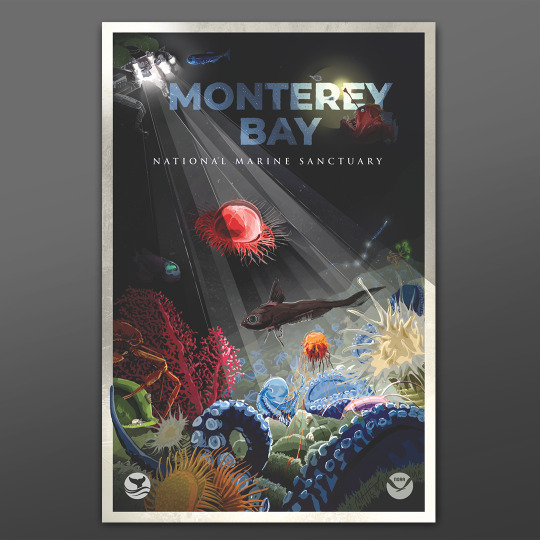
Just in time for World Ocean Day, we are unveiling the Monterey Bay National Marine Sanctuary commemorative poster!
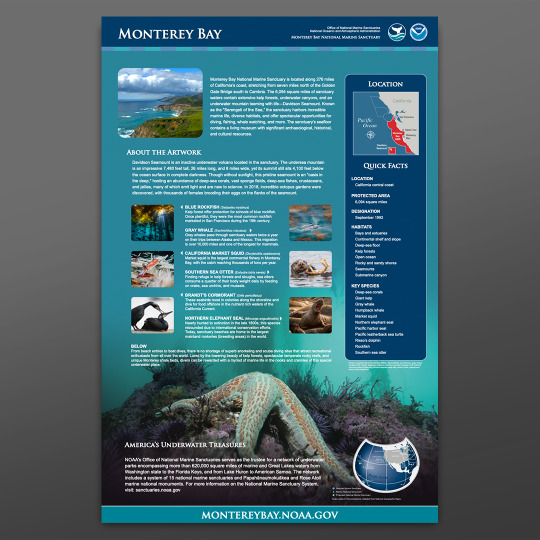
Monterey Bay National Marine Sanctuary is located along 276 miles of California's coast, stretching from seven miles north of the Golden Gate Bridge south to Cambria. The 6,094 square miles of sanctuary waters contain extensive kelp forests, underwater canyons, and an underwater mountain teeming with life Davidson Seamount. Known as the "Serengeti of the Sea," the sanctuary harbors incredible marine life, diverse habitats, and offer spectacular opportunities for diving, fishing, whale watching, and more. The sanctuary's seafloor contains a living museum with significant archaeological, historical, and cultural resources.
Take a look for yourself and download the poster today:
Illustration by Matt McIntosh/NOAA #OceanMonth
#OceanMonthNOAA#Ocean#DavidsonSeamount#Monterey#MontereyBay#Artwork#Illustrations#SaveSpectacular#WorldOceanDay#nature#science
118 notes
·
View notes
Text
Whale fall masterpost
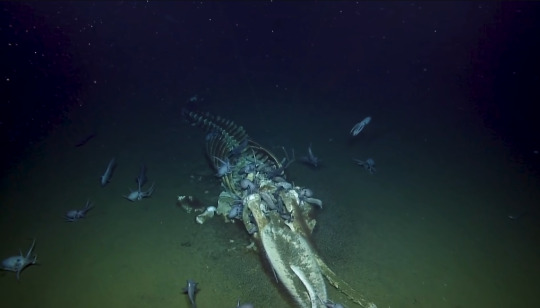
A whale fall occurs when the carcass of a whale has fallen onto the ocean floor at a depth greater than 1,000 m.
On the sea floor, these carcasses can create complex localized ecosystems that supply sustenance to deep-sea organisms for decades.
image source
Just a list of cool materials I found online about whale falls. I'm starting a project to write a (video?)essay on the topic. I'll be probably updating this from time to time until the project is finished.
Video format
Whale Fall Actively Devoured by Scavengers at Davidson Seamount | Nautilus Live
The Stages of Whale Decomposition
Baleen Whale Fall Becomes a Deep Sea Banquet at Davidson Seamount | Nautilus Live
#I'm really excited about starting this project#I've never done something like this before (at least not sharing it with other people outside my close friends) so I hope I won't mess up#ocean#whale falls#kermit .wip#cetaceans#kermit .txt#bones
8 notes
·
View notes
Text
마스크 걸 야스 씬 시간대 좌표 나나 대역
마스크 걸 야스 씬 시간대 좌표 나나 대역 전라노출 합니다. 뒤태 엉덩이까지 다 나옵니다.
마스크 걸 야스 씬 시간대 좌표 나나 대역 사이트: https://m.facebook.com/media/set/?set=a.122094670676025430
5화 6화 위주로 나나 교도소 엉덩이 전라노출 대역 아니라고 발표 했습니다.
그밖에 마스크걸 노출 수위 exid 정화, 이한별 가슴 나옵니다. 6화 교도소 장면 하이라이트 엑기스 시간대 집중하세요.



심해 문어는 일반적으로 지구에서 가장 까다로운 환경 중 하나인 추운 바다에 서식하는 고독한 생물입니다.
01 가장 오래된 해파리 일로
캐나다 로키산맥에서 발견된 가장 오래된 해파리 종
2018년에 바다 표면에서 약 2마일 아래에서 다리가 8개인 두족류 수천 마리가 발견되자 해양 과학자들은 당황하면서도 매료되었습니다. 끝없는 어둠의 장소인 자정대라고 알려진 약 3,200미터 아래 열수 분출공(따뜻하고 화학 물질이 풍부한 액체가 흘러나오는 해저의 개구부) 주변에 모여 있는 문어 무리입니다.
캘리포니아 몬트레이에서 남서쪽으로 128.7km 떨어진 사화산인 데이비슨 마스크 걸 야스 씬 시간대 좌표 나나 대역 시마운트(Davidson Seamount) 기슭 근처의 작은 언덕에서 발견된 문어 정원에는 무우옥토퍼스 로부스투스(Muusoctopus Robustus)라는 종이 가득했는데, 그 이유는 연구팀이 진주 문어라는 별명을 붙였기 때문입니다. 거꾸로 알을 보호하는 동안 그들이 보는 방식.
이번 발견은 지구상에서 가장 큰 것으로 알려진 문어 집단입니다. 연구자들은 현장의 한 부분에서만 6,000마리 이상의 문어를 발견했습니다.
“우리는 거기에 20,000마리의 문어가 있을 것이라고 생각합니다. 그리고 질문은, 음, 그들이 왜 그곳에 있는 걸까요? 그리고 그들은 왜 모이는 걸까요? 이 샘에서 뿜어져 나오는 따뜻한 물이 이 동물들이 그곳에서 번식하는 이유를 알려주는 열쇠인 것 같습니다.”라고 Monterey Bay Aquarium Research Institute의 수석 과학자인 Jim Barry는 말했습니다.
수요일 Science Advances 저널에 발표된 새로운 연구에 따르면, 연구자들은 문어가 짝짓기와 둥지를 짓기 위해 엄청난 수의 심해 온천으로 이동한다고 믿고 있습니다. 알을 낳은 후 문어 어미는 알을 깨끗하게 유지하고 포식자로부터 알을 보호합니다. 기온이 따뜻해지면 생물체의 배아 발달 속도가 빨라집니다.
“매우 긴 육추 기간은 어미의 알이 생존하지 못할 가능성을 높입니다. 어미 문어는 열수 온천에 둥지를 틀면서 새끼에게 다리를 뻗게 해줍니다.”라고 연구의 주요 저자인 Barry는 설명했습니다.
10,500피트의 주변 수온은 화씨 35도(섭씨 1.6도)입니다. 그러나 문어 텃밭의 틈과마스크 걸 야스 씬 시간대 좌표 나나 대역 틈새의 수온은 화씨 51도(섭씨 11도) 정도에 이른다.
최첨단 수중 기술 덕분에 연구자들은 문어 정원을 이해할 수 있었습니다.
Monterey Bay Aquarium Research Institute의 연구원과 다른 기관의 동료들은 최첨단 수중 기술을 사용하여 문어 정원을 이해했습니다.
연구소의 ROV Don Ricketts는 2019년부터 2022년까지 14일 동안 현장에 대한 후속 다이빙을 진행하여 문어의 고화질 비디오를 촬영하고 미터 규모의 해상도로 문어 정원을 매핑했습니다.
원격으로 작동되는 잠수정에는 문어의 행동을 장기간 관찰하기 위해 온도와 산소 수준을 측정하는 저속 촬영 카메라와 센서도 남아 있습니다. 카메라는 2022년 3월부터 2022년 8월까지 약 12,200장의 이미지를 촬영해 20분 간격으로 이미지를 촬영했다.
연구원들은 문어의 알이 2년 이내에 부화한다는 사실을 발견했습니다. 이는 팀이 예상했던 것보다마스크 걸 야스 씬 시간대 좌표 나나 대역 훨씬 빠른 속도입니다.
이 정보를 바탕으로 과학자들은 왜 문어가 그 장소에 끌리는지 알아냈습니다. 흉터와 기타 뚜렷한 특징을 통해 과학자들은 개별 문어와 새끼의 발달을 모니터링할 수 있었습니다.
성체 수컷과 암컷 문어, 발육 중인 알, 부화한 문어의 존재는 해당 장소가 번식지와 종묘장으로만 사용되었음을 나타냅니다. 팀은 중간 크기의 개체나 먹이를 먹는 증거를 관찰하지 못했습니다.
“우리는 부화한 새끼들이 헤엄쳐 가는 것을 봅니다. 우리는 그들이 바로 여기에 살고 있음을 시사하는 작은 동물을 본 적이 없습니다. 그래서 그들은 어딘가로 헤엄쳐 가서 삶을 시작합니다.”라고 Barry는 말했습니다.
연구에 따르면 알은 팀이 예상했던 것보다 훨씬 빠른 속도로 2년 이내에 부화하는 것으로 나타났습니다. 심해 문어 한 종은 4년 반 동안 알을 품습니다. 영하로 내려가는 심해의 열수분출구를 벗어나면 알을 품는 기간이 수년 동안 지속되는 것으로 생각됩니다.
“이 따뜻한 물에서 품는 것은 위험하지만 – 계란을 요리할 수도 있고, 비정상적인 현상이 있을 수도 있습니다. – 알을 낳는 기간이 짧을수록 이점이 생기며, 우리는 무엇이 공정해 보이는지 알기 때문에 완벽하게 작용하는 것 같습니다. 부화율이 높다”고 말했다.
과학자들은 캘리포니아 몬트레이 해안 앞바다의 이 지역이 번식지와 묘목장으로만 사용되고 있다고 믿고 있습니다.
2 notes
·
View notes
Text
Discovered in the deep: an octopus’s garden in the shade https://www.theguardian.com/environment/2023/aug/23/discovered-in-the-deep-octopus-garden-davidson-seamount-california-like-hot-tub-hatchery
1 note
·
View note
Text
Davidson Seamount Unveiled: The Unseen Mountains and Hidden Treasures Off California's Coast
The Octopuses Garden on Davidson Seamount in California. Photo Credit: Chad King / OET, NOAA
If you’ve ever looked out at the vastness of the ocean, you might think it’s a uniformly barren and flat landscape below the tranquil or tempestuous waves. But you’d be mistaken. Imagine for a moment a hidden world of underwater mountains, volcanoes that never broke the water’s surface. These enigmatic…

View On WordPress
0 notes
Link
[ad_1] It was the last hour of a 30-hour dive, nearly two murky miles below the ocean’s surface.A remotely operated vehicle called the Hercules was exploring the foothills of the Davidson Seamount, an underwater volcano about 90 miles southwest of Monterey. Aboard the boat carrying researchers monitoring the Hercules, it was expected to be a fairly boring dive, said Chad King, the chief scientist on the 2018 cruise. Much research had been done near the top and slope of the seamount, but King and his fellow scientists wanted to explore around its base, expecting to find little sponges or corals amid lots of seafloor muck.But then, just as Hercules crossed over a ridge, a curious sight floated across the screen: small, almost iridescent bulbs clinging to the seamount wall. The scientists directed Hercules down, farther into the depths.“And sure enough, that’s where we ran into thousands and thousands of these octopus,” King said. “And we were just absolutely floored. We were just giddy.”The scientists, led by the National Oceanic and Atmospheric Administration’s Monterey Bay National Marine Sanctuary, had alighted upon what they called an “octopus garden.” The images they captured revealed nearly 6,000 octopuses — leading scientists to estimate the total population of the area could exceed 20,000.The discovery of the thousands of Muusoctopus robustus — or “pearl octopus,” as researchers dubbed it for the animal’s shape and opalescent shine — led a team of scientists on a five-year quest to solve the mystery: Why are there so many thousands of pearl octopuses at the foot of the Davidson Seamount, and how were they living there? The researchers visited Octopus Garden more than a dozen times to find out, and a study published last week in the journal Science Advances shows they solved one part of the mystery. The pearl octopus came to the Davidson Seamount, they discovered, to nestle into the warm crooks of its wall and brood baby octopuses.The ambient temperature of water around the seamount is about 35 degrees Fahrenheit, according to Monterey Bay Aquarium Research Institute scientists. But by using sophisticated marine thermometers, the researchers found that the octopuses were settling into crevices warmed by spring water, where the temperature reached nearly 51 degrees.“So we’re still unsure exactly about what kind of geological circulation drives these springs, but essentially water’s getting heated somewhere underground there,” said Steve Litvin, marine ecologist at the institute. “And just like a warm spring, you know, I don’t want to say ‘Old Faithful,’ but it’s bubbling up there out of the rocks.”The relatively warm spring water raises the mother octopus’ metabolism, speeding up the egg development process. Researchers found that octopus eggs in the area hatch in less than two years — far less than the estimated five to eight years it takes in colder temperatures.“They’re in warm water, the metabolism is much faster,” King said, “so their life history has been very compressed relative to most deep-sea animals.”Solving one mystery only ignited a burst of other questions for the scientists: Where did the octopus come from? Do they instinctively know that the warm waters will speed up the brooding process? How many other octopus nurseries exist on the seafloor around the world? “We know so little about the deep ocean,” Litvin said. “The discovery of the garden and all these thousands of octopus … just highlights that this is the biggest ecosystem on our planet, and we know less about it than we know about the surface of the moon.”Scientists still don’t know where the grapefruit-sized octopuses came from, or how they knew to settle against the Davidson Seamount’s warm rocks. But over years of monitoring them, they watched the octopuses mate, settle, brood and hatch new offspring.Once an egg is hatched, the mother octopus dies. Shrimps, snails, anemones and other organisms feed off the octopus’ carcass. Most deep-sea animals rely on food floating down from the ocean surface — “marine snow,” Litvin called it. But with such a large number of octopuses living and dying in one area, he said, they provide the seafloor community “about 70% more carbon, more food than if only that marine snow was coming down.”“You wouldn’t see this specific ecosystem at the garden,” Litvin said, “if it wasn’t for all those octopus dying.”Once a new octopus is hatched, the juvenile swims off into the darkness, Litvin said. Where does it go? That’s a question for future research to answer, he said.“That’s the largest aggregation of octopus in the world,” Litvin said. “So the thought that these kinds of ecosystems are still hiding from us — that after a couple of decades of a lot of deep-sea exploration, there’s still that scale of a discovery — is just amazing, and really highlights the need for continued investment in technology so we can expand our efforts to explore the deep sea, find the next Octopus Garden and literally, again, understand how that biggest ecosystem in our planet works.”___ [ad_2]
0 notes
Text
Atop an Underwater Hot Spring, an ‘Octopus Garden’ Thrives
In 2018, Amanda Kahn, an invertebrate biologist at San Jose State University, joined an ocean expedition to scout the base of Davidson Seamount, an inactive underwater volcano off the coast of central California. She came for the sponges and corals.
But she and her colleagues stumbled across something much more astounding. As their remotely operated vehicle, which was probing the seafloor and…
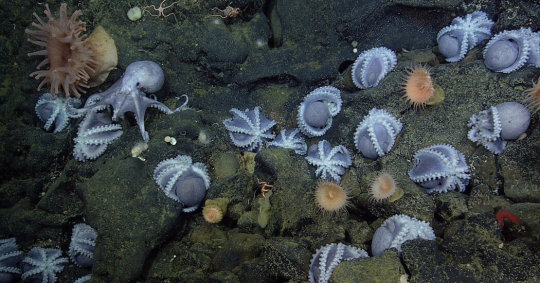
View On WordPress
0 notes
Text
The Bold Journey to Reveal Every Dark Inch of the Ocean Floor
The Bold Journey to Reveal Every Dark Inch of the Ocean Floor
Photo Illustration by Thomas Levinson/The Daily Beast/OET Nautilus Live/Getty
The water is murky as lights from an unmanned submersible shine on the seafloor, more than 10,000 feet below the surface. As the vehicle slowly moves through the depths of the Davidson Seamount off the coast of central California, a team of researchers observing everything remotely murmur in excitement as a giant corpse…
View On WordPress
0 notes
Link
2 notes
·
View notes
Text
More Octopus Garden goodness coming right atcha! 🐙✨
Deep below the ocean’s surface, just off the Central California coast, thousands of octopus gather near an extinct underwater volcano. The Octopus Garden is the largest known aggregation of octopus anywhere in the world. In 2018, researchers first observed thousands of pearl octopus (Muusoctopus robustus) nesting on the deep seafloor at this site near Davidson Seamount.

Over a period of three years, MBARI and a team of collaborators used high-tech tools to monitor the Octopus Garden and learn exactly why this site is so attractive for deep-sea octopus. These images are from a 4K time-lapse camera we deployed at the site for six months, from March 2, 2022, to August 26, 2022. This advanced camera platform operates at extreme pressure two miles deep (3,200 meters).

We captured and stored a photo every 20 minutes—the result is a remarkable peek into the cycle of life at this unique biological hotspot. Watch more incredible video captured at the Octopus Garden on our YouTube channel.
248 notes
·
View notes
Link
I’m sure you all remember this from last year, when the E/V Nautilus found the “octopus garden”?
youtube
Well, they’re going back this year. FYI. It’s their last dive of the season, in fact. As of this typing, they’re in transit.
You can watch at the link above, or on youtube. There are three views you can watch, Channel 1 shows just what the main ROV sees, Channel 2 shows what it’s tether-buddy ROV sees (an overhead view), and Quad, which shows both of those, plus two more screens that sometimes show the interior of the room the scientists are in, sometimes a third underwater camera view, sometimes their position on the map, sometimes other things.
Any time they’re diving ,you get audio from the scientists, and that’s great fun as well.
youtube
Anyway, it’s great fun. Even when they’re in blue water or going over blank sand, the nerd conversation is worth listening in on.
#ev nautilus#nautilus live#e/v nautilus#rov#diving#ocean#octopus#octopus garden#davidson seamount#monterey bay
1 note
·
View note
Text

Baleen whale's rib cage on the sea floor. Found at Davidson Seamount. Source: EVNautilus
Part of my project on whale falls will be focused on the little critters that come together at the whale's grave.
As you can see here (just look at the red “mush” on the bones), a lot of those guys are actually worms! This species is thought to have hemoglobin, hence the color red.
#whale falls#kermit .wip#bones#ocean#cetaceans#a lot of wild stuff about these little fuckers. stay tuned for mind blowing worm facts.
2 notes
·
View notes
Text
Davidson Seamount is a deep-sea oasis of life. Help keep it protected!

A benthic octopus on Davidson Seamount (credit: NOAA)
It took seven years of research, collaboration and public input to get Davidson Seamount protected as part of Monterey Bay National Marine Sanctuary. Now those protections could be weakened or removed due to April’s White House executive order calling for a review of national marine sanctuaries and monuments—potentially to open up these blue parks for offshore oil and gas drilling. Please let the administration know that the ocean needs more protection, not less.
How you can help:
Speak up for America’s protected waters by adding your comment to the official Federal Register
Check out our Conservation & Science blog post for suggested talking points about the benefits that national marine sanctuaries bring to people, wildlife and the economy
And read on to see what makes Davidson Seamount such an important place to protect (and geek out about!)...
What is Davidson Seamount?
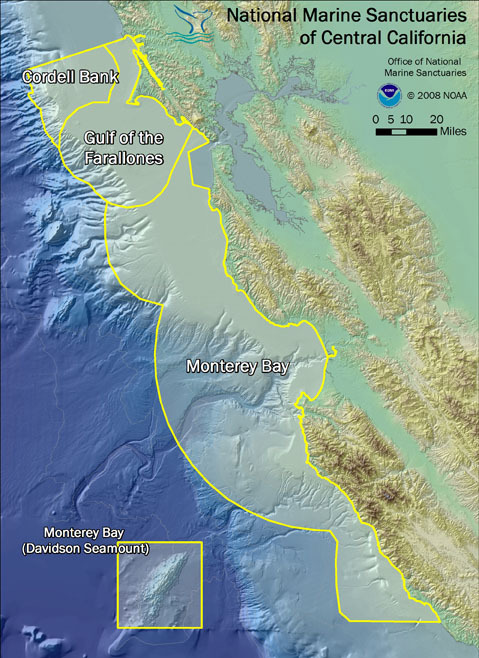
Davidson Seamount sits 70 nautical miles southwest of Monterey (Credit: NOAA)
Davidson Seamount is one of the largest seamounts in the world. Picture a volcano that's 23 nautical miles long, seven nautical miles wide and 7,480 feet tall. Now imagine that the top of that volcano is still 4,101 feet below the surface of the sea, and the whole place is home to countless fascinating deep sea creatures. That’s Davidson Seamount!
While Davidson Seamount was discovered in 1933, the first video images weren't produced until 2000, when our colleagues at Monterey Bay Aquarium Research Institute (MBARI) and National Oceanic and Atmospheric Administration (NOAA) teamed up for a joint survey of this vast undersea habitat. The images they brought back sparked national interest and a conversation about protecting the seamount began. NOAA, MBARI and other research partners set out to learn more about this place. What they discovered amazed them:

Researchers found vasts forests of corals including bubblegum coral, a deep sea species that can live hundreds of years, grow over eight feet tall and provides habitat for other organisms. (Credit: NOAA)
"We were blown away by the size, age, and diversity of deep-water corals we saw during the 2002 Davidson cruise. Indeed, the discoveries we made during that cruise prompted members of the public to propose Davidson Seamount be protected as part of the Monterey Bay National Marine Sanctuary. We wanted to go back to learn why so many extraordinary corals thrive there and to determine their age and growth patterns." - Andrew DeVogelaere, chief scientist of the 2006 expedition

Venus flytrap anemone on Davidson Seamount (Credit: NOAA and MBARI)
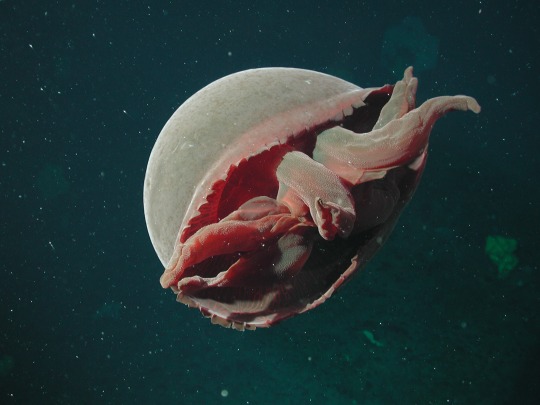
Tiburonia granrojo jelly at Davidson Seamount (Credit: NOAA and MBARI)
Researchers found that Davidson Seamount was a pristine “oasis of life” that provided habitat for numerous deep-sea creatures, including several previously undiscovered species found over the course of their explorations. The seamount also supports life above and around it, as the water above seamounts are productive feeding grounds for a wide variety of fishes, marine mammals, and seabirds.
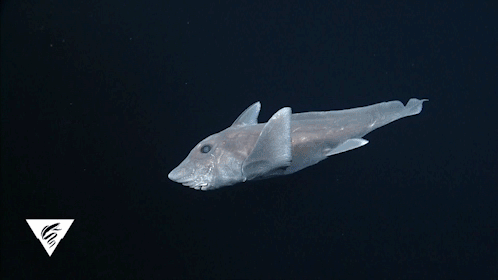
A ghost shark (pointy-nosed blue chimaera) spotted near the summit of Davidson Seamount.
Seven years after calls to protect Davidson Seamount were first proposed, Monterey Bay National Marine Sanctuary expanded to include this unique deep-water habitat. Achieving this took a careful, multi-year process that involved input from the public and evaluation from a working group of key stakeholders, including research scientists, educators, fishermen, marine conservation groups and ocean management agencies.
Today, Davidson Seamount and the amazing deep-sea creatures that call it home are protected. To help keep it that way, add your comment to the official Federal Register.
If you’d like dive into more of the life found on Davidson Seamount, our friends at MBARI have lots of great articles and videos from their explorations, like this:
youtube
#Davidson Seamount#seamounts#deep sea#deep-sea creature#ghost shark#jelly#octopus#flytrap anemone#MBARI#Monterey Bay Aquarium Research Institute#Monterey Bay Aquarium#sciblr
581 notes
·
View notes
Text
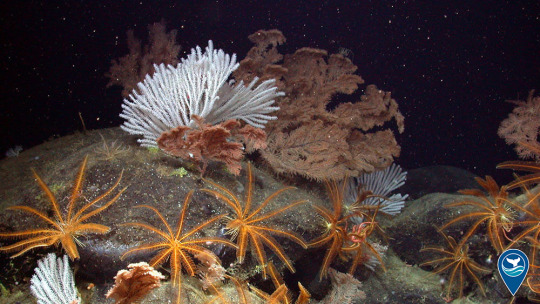
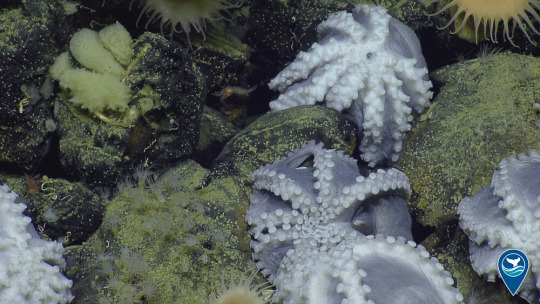
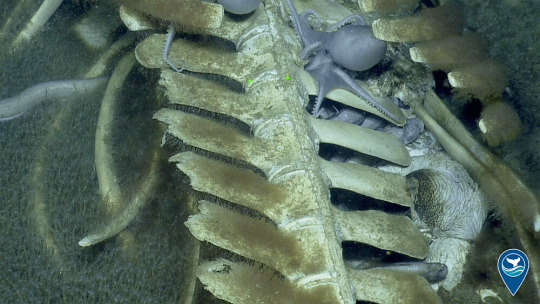
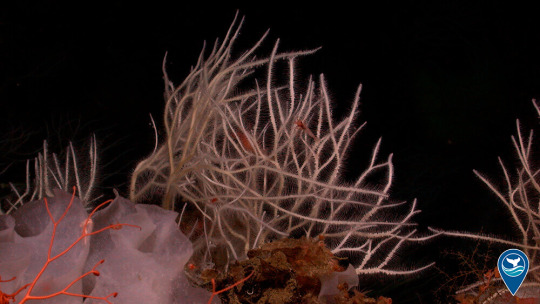
Davidson Seamount, located 80 miles southwest of Monterey, California, was first mapped in 1933 and was the first undersea feature to be characterized as a “seamount." Roughly 200,000 seamounts exist throughout the world, but relatively few have been explored and protected. Since the first biological expedition to Davidson Seamount in 2002, it has been globally recognized as one of the best studied and most protected seamounts.
Learn about some of the cool findings made in Monterey Bay National Marine Sanctuary and how this protected seamount teaches us about unique geologic formations deep in the ocean that contribute to ecological quality and ocean productivity.
Read it here: https://sanctuaries.noaa.gov/news/may22/explore-spectacular/10-discoveries.html
#Biodiversity#DavidsonSeamount#EarthIsBlue#SaveSpectacular#MontereyBay#OceanGardens#BlueEconomy#Underwater
129 notes
·
View notes